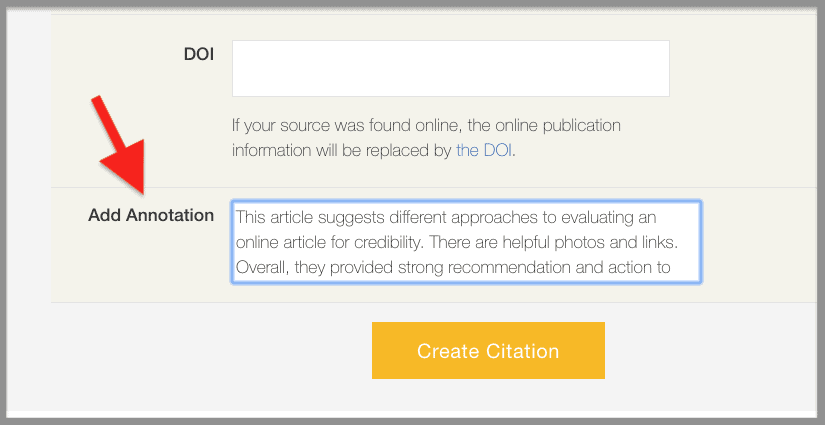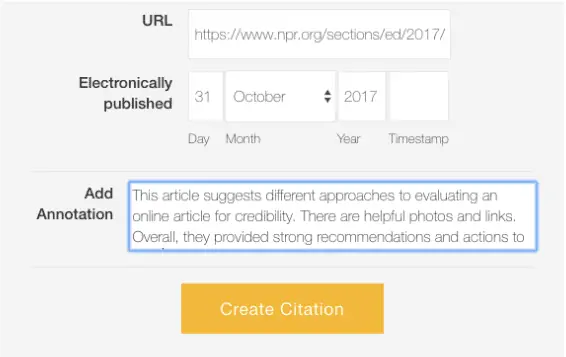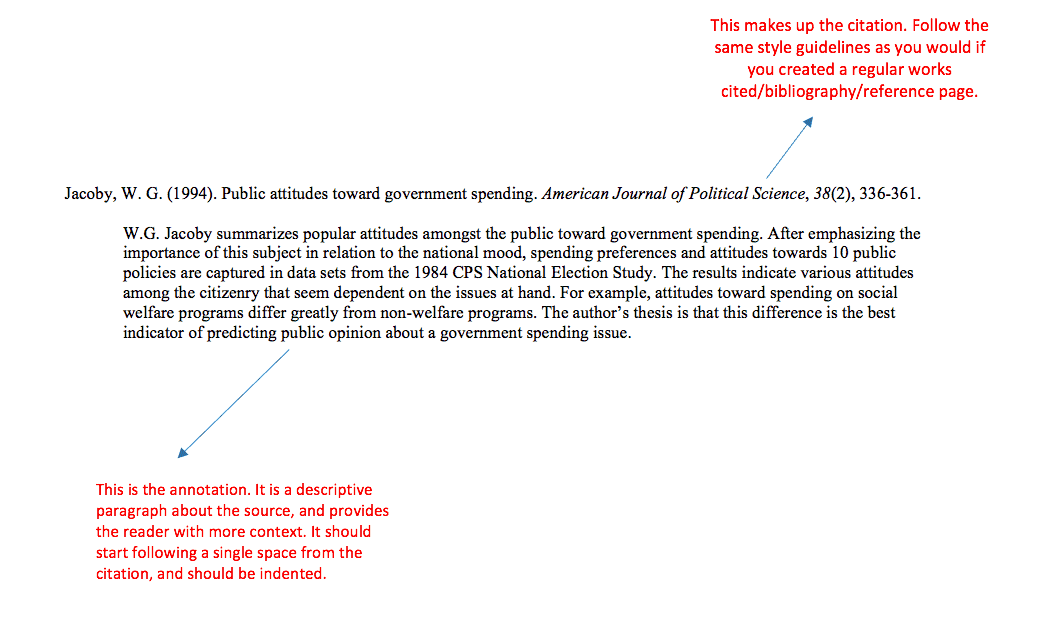
Feature Focus: BibMe’s Intuitive Annotation Tool
Were you asked to create an annotated bibliography? Wondering how to write an annotated bibliography? Or even what it is? Look no further, because BibMe’s free Annotation Tool can help!
Bibliographies are generally found on the final page of an assignment or research paper and contain citations for sources used in a project. Annotated bibliographies take it one step further and include the full citation PLUS commentary about the source.
The commentary about the source is the annotation. Included in this commentary, or annotation, is:
- A summary of the source (one to three sentences)
- Your evaluation of the source and how or why you found it beneficial (one to three sentences)
-
Here’s an example of an annotated bibliography, in APA format, created with BibMe’s free Annotation Tool:
Civil Rights Movement. (n.d.). Retrieved January 16, 2018, from http://www.history.com/topics/black-history/civil-rights-movement
This website features articles, videos, pictures, and speeches that pertain to the Civil Rights Movement. Included are brief summaries of historical events and notable people, including the March on Washington, Bloody Sunday, and the Little Rock Nine. I appreciate the brief overview of many significant events and the primary sources throughout were beneficial for this assignment.
Lee, H. (2002). To kill a mockingbird. New York, NY: Harper Perennial Modern Classics.
Based in Alabama in the early 1960s, Atticus Finch defends a black man during his rape trial. Scout Finch, Atticus Finch's brave 6 year old daughter, narrates the story and walks us through a time of racial and social injustice. The novel shed light on life in Alabama right before the civil rights movement took off and allowed me to understand the time through an innocent child's eyes.
Ready to make your own annotated bibliography with BibMe’s Annotation Tool? To do so, create your citations as you normally would on BibMe. At the final step, you’ll see “Add Annotation” at the bottom of the citation form. You can also get here by clicking on the “Edit” link on an existing citation.
Add your summary and evaluation in the box. BibMe will format your citation, with annotation, in the proper format and in the style you choose (MLA style, APA format, Chicago, or another style). After you create your citation with its annotation, copy and paste it into your bibliography, download it to Word, or save it for later use. It’s simple, easy, and free! Doesn’t get better than that!
If you need more help with your bibliography, works cited list, or reference list, check out our citation guides. We also have a great grammar check feature to help you build a paper you're proud of.

4 Ways to Battle Writer’s Block (and Win)
by Amanda Clark
Writer’s block. We’ve all experienced this demon. You get an assignment, sit down to begin, and BAM! Nothing. Or you write a stellar first page, feel like a writing rock star and then—BAM! Nothing.
When you have deadlines to meet, a foggy brain can be more than a nuisance. Next time, skip the stress and try these techniques for battling writer’s block—and winning. (And don’t forget to run your paper through a grammar checker before handing it in!)
- Take a break
It may sound counterproductive, but one of the best things you can do to battle writer’s block is take a break. Go for a run, watch an episode of This is Us, or even do your math homework. Whatever you do, the important thing is to take a break from slaving over your assignment.
Sometimes our minds just need a writing siesta. When you return in an hour or two, you might be surprised to find that when you sit down to type that paper on the periodic table, your fingers fly with style.
- Read something related to your topic
It’s easy to get writer’s block after you run out of ideas. After getting off to a strong start, your train of thought derails, frustration sets in, and before you know it, an hour has rolled by and you’re still staring at a blinking cursor.
Don’t let this happen to you! When you’re out of fresh ideas, hit the books.
Let’s say you’re writing a paper on the Civil War. Well, bust out your old history textbook and get reading. Or maybe you have to write a poem, and you happen to have your favorite book of poetry by Billy Collins lying on your desk.
Read these nuggets of inspiration, and they could very well get your thoughts flowing again.
They might even beef up your works cited page. Sweet!
- Reach out to others
It’s easy to stay connected through Snapchat updates and Instagram stories. So why not use your friends and family as resources to help you out when you're stuck?
Having some issues writing about music theory? Facebook your Uncle Ronny who majored in music. Can’t think about how to develop the plot of your story for a creative writing class? Text your friend Lila whose last short story received an “A.” Just make sure to cite sources!
You can even get coffee and have a face-to-face conversation about your struggles, and let collaboration magically heal writer’s block.
- Change your surroundings
So you may love to study and write at the local pizza joint because it has great munchies and free Wi-Fi. But if you’re finding it difficult to concentrate with the football game playing on TV and the soda fountain gurgling, it might be best to move to a different environment.
Try to find someplace quiet and uncluttered. Maybe you’re most productive at a small park or the library. Finding your ideal work location could save you hours of time in the long run.
If you're sick of staring blankly at that computer screen, take a deep breath. Then try one of these four techniques for battling writer’s block. You should be finishing that assignment in no time!
Once your paper is written, make sure your bibliography is just as sharp! BibMe’s citation generator is an easy and fast way to create citations in MLA style, APA style and more.
...
Community College vs University: What’s Right for You?
By Ella Chochrek
For many students, choosing their next steps after high school can be difficult. The right choice for one student might be to enter the workforce, while another might prefer to get a bachelor’s degree straightaway.
Before pursuing higher education, it’s important to assess the pros and cons of all available options. Here, we’ve laid out some of the pluses and minuses of both community college and four-year degree programs to help you determine which is best for you. While reading this, keep in mind that neither choice is better or worse—community colleges and four-year colleges both provide students with quality educations.
Pros to Community College
1. Lower Costs
The price of four-year colleges and universities has skyrocketed in recent years, with some institutions costing over $65,000 annually in room and board. At a public two-year college, the average yearly price is around $3,500—not cheap, but a fraction of the price of a four-year college degree. Attending a community college for two years before switching to a four-year institution could result in tens of thousands of dollars saved.2. Flexible Class Schedules
For students hoping to attend college only part-time or to pursue an education while also working a full-time job, community college may fit the bill. Community colleges are often designed with the part-time student in mind, making it easy to take limited credit hours each semester or to take classes that meet at nights or on the weekends—two options that are difficult to come by at many four-year colleges.3. Smaller Classes
While many introductory-level classes at large universities—including prestigious schools—are large lecture courses with more than 100 students, community college class sizes are typically smaller. In these smaller courses, which may have around 20 members, students can get to know their professors on an individual basis—something that is beneficial when it comes time to ask for recommendation letters. Similarly, students may feel more comfortable seeking help for difficult material in a more intimate classroom setting.Pros to Four-year College/University
1. Campus Life
When you picture the college experience portrayed in movies and on TV, you probably picture the four-year college experience, complete with dorm rooms, extracurricular activities, and a lively social scene. Although community colleges do have some clubs and organizations, extracurricular opportunities will be much more plentiful at four-year colleges and universities. Similarly, if you’re looking for a rah-rah environment with team sports and school pride, a four-year college is the place for you. 2. Broader Curriculum
Four-year colleges and universities offer all types of interesting courses that go far beyond general education requirements, including courses in areas like philosophy and anthropology that might not seem overwhelmingly relevant to your post-graduate plans. While community colleges also offer some interesting courses, most classes will probably be focused around specific jobs (like auto repair or medical technology). A four-year college is the way to go if you want to learn for the sake of learning, rather than to fulfill requirements or advance a certain career path .3. Big Potential Payoffs
A four-year degree is required before pursuing a master’s degree or a doctoral degree, so if you hope to become a doctor or a lawyer, attending a four-year institution from the get-go is probably the right choice for you. In general, most high-earning fields require at least a bachelor’s degree, meaning that despite the initial high costs of college education, the investment ultimately results in a high payoff.Every person and their path is different. The important thing is to think through what your priorities and what you hope to gain from your higher education experience before making your decision.
—
Get help with your papers: Learn how to cite sources and how to do a works cited page.
...

The 5 Writing Secrets I Wish I’d Known in High School
by Muranda Mendez
As a college student, I’ve learned new tips and techniques that have made me a stronger, more efficient writer—and even made the writing experience more enjoyable. Sometimes I've found myself thinking, “I wish I’d known this earlier!”
So, here are five writing secrets that I’ve discovered in college that I wish I’d known as a high school student.
1. Find something you like about the topic
It can be hard to write if you don’t think the topic is interesting, or if you’re only writing with your teacher (and their gradebook) in mind. Of course, sometimes a paper topic is just uninspiring. But if you strive to find something you find personally interesting, the writing process will be a lot more enjoyable, whether it’s a literary paper or a research paper. If you find something you like, the writing process will be easier, and the end product will be more fun and interesting to read.
In high school, I dreaded Shakespeare. I found his writing dense, even more so when I knew I’d have to write about it. In college I also encountered Shakespeare, but I learned to pick something about his plays I actually enjoyed exploring. Rather than focusing on the entire play, I picked pieces such as nature symbolism or gender relations. It made writing about Shakespeare a lot easier.
2. Write five sentences
Figuring out where to start can be more difficult than actually writing the essay. If you’re having trouble, try writing out five sentences that could compose your essay. Here’s an example:
- Thesis: This is the sentence that states your argument and how you’re going to prove it.
- Example: A lot of students view essay-writing as a tedious task, but it can actually be fun and a great way to express themselves.
- Body #1: This is the sentence that begins the process of proving your argument.
- Example: Students focus mainly on achieving a good grade or pleasing the teacher, rather than the writing itself, making it seem more tedious and boring.
- Body #2: This sentence proves your argument in a new way.
- Example: If students focused more on what interested them, their writing would improve and the process would be more enjoyable.
- Body #3: This sentence is either a counterargument or another way to show how and why your argument is right.
- Example: They would express their opinions with more passion, making the final product more well-rounded and interesting to read.
- Conclusion: This sentence summarizes your argument.
Example: While many students view essays as a boring task, with the right mindset and set of tools it can actually be an enjoyable and enriching experience.
Often, the hard part of writing is actually organizing your thoughts. Once you have the outline sentences written, the paragraphs will be easier to fill in!
3. Use sources
Before college, I viewed the requirement to cite sources in my papers as an obstacle to overcome. In college, though, I’ve discovered that sources can actually be a valuable writing resource.
If you’re struggling with what to say, try finding sources on the topic. Often when I’m writing, I find a source that helps me think about the topic in a way I haven’t previously. This not only gives me more ideas about what to write, but it also helps me argue against potential counterarguments to my thesis.
While you don’t want to make your essay too “source heavy,” using sources to support your argument shows that you have research skills and makes your writing more sophisticated. Just make sure to accurately cite, whether you’re using Chicago style format or MLA style!
4. Focus on the “how”
When writing an essay, it’s easy to get stuck on the “what” or the “why.” If you focus on the “how” instead, you’ll have more to write about and your analysis will go deeper.
For example, instead of writing about “what” theme the author is trying to convey, write about “how” the author conveyed that theme. If you focus only on the “what,” you’re just reaching the surface of the argument. Writing about “how” allows you to write about symbolism, metaphors, foreshadowing and more for a literary analysis essay, or historical context, social implications and more for a research paper. You might find yourself exceeding your teacher’s word count!
5. Jump, jump, jump around
It might seem like it would be easiest to write your essay from beginning to end. However, jumping around helps keep you engaged on your assignment and makes it easier when you get stuck.
This is where the five sentences trick also come in. After you write the five sentences, you can go back and forth filling them in. Sometimes an idea for a different paragraph might come to mind, and it makes sense to write that idea in rather than feeling obligated to stay on the paragraph you’re currently writing. When you edit and run a grammar check, you can make sure everything fits well together. Sometimes I find that my essays have a stronger, more cohesive argument the more I jump around, because an idea from one paragraph inspired the next paragraph.
Becoming a better writer is a process that’s unique to everyone. However, these five tips and techniques have helped me enjoy writing more than ever before, as well as getting better at it. Try them in high school, and you’ll likely find you’re more prepared for college writing!
...
Does Anyone Really Know How to Use a Semicolon?
by Muranda Mendez
You’ve seen them in grammar handouts from teachers, pushed somewhere between warnings on overusing commas and misplacing apostrophes. Maybe you’ve tried to stick one in your essay, checking 10 times to make sure you were using it correctly.
The semicolon has puzzled students for decades. It seems so smart and sophisticated—but how do you know you’re using it right?
Simply put, a semicolon is a punctuation mark that is used to separate two independent clauses. So what is a clause exactly? A clause is part of a sentence that contains the subject and verb. The key to using a semicolon is that you’re connecting two independent clauses, meaning that it expresses a complete thought. So by using a semicolon, you’re connecting two sentences which could stand on their own.
Sound confusing? Let’s look at some examples:
This is a dependent clause:
When the students formed a study group for their quiz.
Notice how this clause can’t stand on its own as a complete sentence.
Now here it is as an independent clause:
The students formed a study group for their quiz.
Now the clause makes sense as a complete thought or sentence. In this case, the word “when” is what makes the dependent clause unable to stand on its own.
Remember, a semicolon can only connect two independent clauses. Here are some examples of misused semicolons- The store was having a huge sale on many items; clothes, toys, and electronics.
- Desperate to fit in with her friends; Mackenzie pretended to have watched the new show.
- While they were swimming; they saw dolphins and turtles.
If you want to check whether or not you’re using a semicolon correctly, just read the two clauses on their own and see if they make sense. If they don’t, it’s a miss. In the first example, a semicolon is used to introduce a list; it should be a colon. The last two examples attempt to connect a dependent clause with an independent clause using a semicolon; it should be a comma. If you’re still not sure you used punctuation correctly, try running your paper through our grammar checker tool.
Finally, let’s look at an example of when you should use a semicolon:
Incorrect: Emily is very smart, she was in advanced reading when she was eight years old.
Correct: Emily is very smart; she was in advanced reading when she was eight years old.
The mistake here was a comma splice. A semicolon fixes that because it allows the independent clauses to stand on their own, while still showing that they’re connected.
All three of these example are correct. The first two connect two related independent clauses. The third separates items in a list that already contains commas, which is another valid use of the semicolon. Another tip for checking if you’re using a semicolon correctly is to substitute in a conjunction (and, or, so, but, yet, for). In the first example above, you could have written, “In English class we read stories, and we also read nonfiction texts.” Using a semicolon allows you to take out the comma and the conjunction!
As you can see from these examples, semicolons don’t have to be intimidating. Hopefully you now feel more confident about adding one into your writing. Your teacher will likely be impressed!
—
More BibMe resources: Get tips on how to cite a website and how to cite a website in MLA.
...
5 Tips to Make Sure You Avoid Plagiarism
by Amanda Clark
Plagiarism: It’s a scary word, and you probably know someone who has gotten into big trouble for it. But with so many writing assignments to do, and so many free resources available, it can be easy to plagiarize accidentally. In fact, there are many “gray areas” of plagiarism that you might not even know about.
In order to avoid a very uncomfortable trip to the principal’s office, here are five tips to help make sure you avoid plagiarism.
- Use a variety of sources
When compiling your research, it’s important to use numerous sources. This prevents you from using ideas from just one site or book. Even though you may think you’re putting the content into your own words, you still may be using the formatting and overall structure of that one author. By using multiple sources, you’ll not only have a more well-rounded paper, but you’ll also avoid accidentally passing off one author’s work for your own.
- Base your work on your own ideas
This one sounds like common sense, but it’s critical. If you’re composing your essay based on your own thoughts and ideas, then you’re probably in the clear of plagiarism.
Try writing out a short draft of your paper using no outside sources. This ensures that you’re thinking through the topic on your own, rather than relying on already-published ideas. This is certainly easier for assignments like short stories, poetry, editorials, etc. than research papers, but the thesis in a research paper should be original too. Make sure that your arguments are backed by cited, credible sources, and that your paper offers a new spin on a topic rather than just recapping old information.
- Cite your sources!
Accurately citing your sources is one of the best safeguards against plagiarism. Remember that you don’t just have to cite when using quotes. You also have to cite ideas that aren’t yours. Many students fail to mention sources because they feel that they put the author’s ideas into their own words, but this is still a form of plagiarism. I tell my students: when in doubt, provide a citation. EasyBib has an easy-to-use works cited generator that helps you create citations, whether your teacher has asked for MLA style, APA style, or Chicago style.
- Stay organized and keep track of your sources
A common mistake that students make is spending hours researching and taking beautiful notes, only to lose track of where the information came from. Help yourself out from the beginning: keep track of your sources as you’re taking notes. Try keeping an organized T-Chart of all of your sources in one column and your information/notes in the other column. This will prevent you from accidentally forgetting a citation.
- Run your paper through a plagiarism checker
Even when you don’t set out to plagiarize, you can forget a citation, fail to adequately rephrase a source text, or accidentally follow the structure of a site you’ve used. Use an online grammar and plagiarism checker to make sure you didn’t accidentally lift something from your research or forget to cite. It only takes a few minutes, and it gives you that extra peace of mind when you turn in your paper.
So the next time you sit down to write that stellar paper on the Roman Empire, make sure to use these handy tips to help you pass any plagiarism checker with ease.
—
For more tips on writing a plagiarism-free paper, check out these resources on how to do a works cited page and how to cite a website.
...

